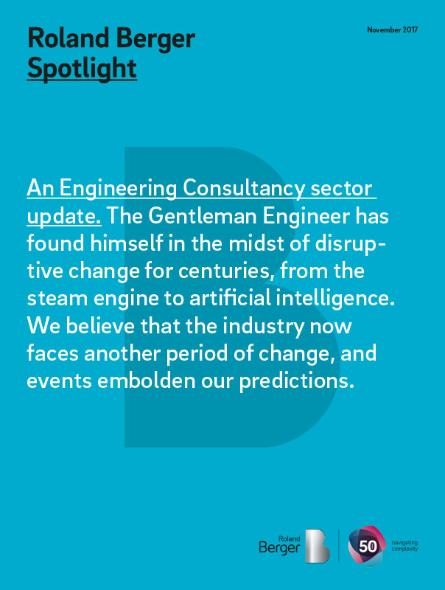From Steam Engine to Artificial Intelligence
![{[downloads[language].preview]}](https://www.rolandberger.com/publications/publication_image/roland_berger_an_engineering_consultancy_sector_update_1_download_preview.jpg)
Engineers have found themselves in the midst of disruptive change for centuries. Currently the industry is facing another period of transformation.


In summer, 2015, Roland Berger published a status report on the engineering consultancy industry and its prospects, making predictions for the five-year strategic time horizon to come. Now, in winter, 2017, we offer a mid-term report. Many of our predictions have borne out. Cycles continue on a sectoral and country level, some of them, like the deep recession in Oil & Gas, felt more keenly than others. But the versatility and intellect of the technical services sector protects it from the worst eventualities, and we believe that megatrends and openness to continued change will see such businesses prosper.
Engineering Consultants design the world's fixed assets, and are at the center of a broader addressable market for technical services worth USD 380 bn. The top 150 of these consultancies have revenues averaging USD 1 bn each, and are among the world's most international professional service firms. In the summer of 2015 the Engineering Consultancy sector was still reeling from the merger of two of its top 10 players: AECOM and URS. Today it is dealing with the merger of another two of its top 10 players: Jacobs and CH2MHill, and another two of its top 10 players: SNC Lavalin and WS Atkins.
When is big too big? Evidence shows, that large Engineering Consulting Companies can be an advantage. Large projects need many hands, and suppliers must be able to deploy large teams without failure. But major Engineering Consulting Companies also require a complex structure of leadership.

![{[downloads[language].preview]}](https://www.rolandberger.com/publications/publication_image/roland_berger_an_engineering_consultancy_sector_update_1_download_preview.jpg)
Engineers have found themselves in the midst of disruptive change for centuries. Currently the industry is facing another period of transformation.

